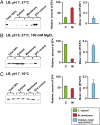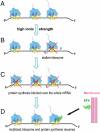Elongation factor 4 (EF4/LepA) accelerates protein synthesis at increased Mg2+ concentrations - PubMed (original) (raw)
Elongation factor 4 (EF4/LepA) accelerates protein synthesis at increased Mg2+ concentrations
Markus Pech et al. Proc Natl Acad Sci U S A. 2011.
Abstract
Elongation factor 4 (EF4) is one of the most conserved proteins present in bacteria as well as in mitochondria and chloroplasts of eukaryotes. Although EF4 has the unique ability to catalyze the back-translocation reaction on posttranslocation state ribosomes, the physiological role of EF4 remains unclear. Here we demonstrate that EF4 is stored at the membrane of Escherichia coli cells and released into the cytoplasm upon conditions of high ionic strength or low temperature. Under such conditions, wild-type E. coli cells overgrow mutant cells lacking the EF4 gene within 5-10 generations. Elevated intracellular Mg(2+) concentrations or low temperature retard bacterial growth and inhibit protein synthesis, probably because of formation of aberrant elongating ribosomal states. We suggest that EF4 binds to these stuck ribosomes and remobilizes them, consistent with the EF4-dependent enhancement (fivefold) in protein synthesis observed under these unfavorable conditions. The strong selective advantage conferred by the presence of EF4 at high intracellular ionic strength or low temperatures explains the ubiquitous distribution and high conservation of EF4.
Conflict of interest statement
The authors declare no conflict of interest.
Figures
Fig. 1.
Growth competition. Equal mixtures of E. coli wild-type cells and ΔlepA cells were grown under various conditions as indicated and the fraction of ΔlepA cells was determined (mutant cells in %), as described in the text and Materials and Methods.
Fig. 2.
EF4 distribution between cytosol and membranes. (Left) Immunoblotting using polyclonal anti-EF4 antibody as described in Materials and Methods. Total, the total amount of EF4 in a cell sample corresponding to the cell fraction used for EF4 determination in the cytosol and membranes, respectively. (Center) Estimates of the relative amounts (%) of EF4 in membrane and cytosol fractions based on the intensities of the corresponding immunoblotting bands. (Right) Molar ratio between EF4 and ribosomal protein S7 in the cytosol fraction based on intensities of corresponding immunoblotting bands (14), using polyclonal anti-EF4 and anti-S7 antibodies; band intensities were calculated as described in Materials and Methods.
Fig. 3.
EF4 effects on rate and accuracy of in vitro protein synthesis. (A, Left) Kinetics at 30 °C of poly(Phe) synthesis under optimal (4.5 mM) and high Mg2+ concentrations (14 mM) using S100 enzymes, which already contain EF4. (A, Right) Leu misincorporation per 1,000 incorporated Phe under the same conditions. (B, Left) Kinetics of oligo(Phe) in a pure system containing precharged 10 Phe-tRNAs per ribosome and the factors EF-Tu, EF-Ts, EF-G, and ± EF4. (B, Right) Oligo(Phe) incorporation in the pure system after 20 min at optimal and unfavorable Mg2+ concentrations (4.5 and 30 mM Mg2+, respectively). (C) Oligo(Phe) synthesis in the pure system incubated 30 °C for 60 min at various K(acetate) concentrations. (D) Oligo(Phe) synthesis in the pure system at various ionic concentrations either at 30 or 20 °C for 20 min as indicated.
Fig. 4.
Model showing EF4 importance at high ionic strength. (A) Normal protein synthesis on polysomes; (B) high ionic strength can lead to a single stalled ribosome on a polysome; (C) upstream ribosomes are therefore blocked stopping protein synthesis on this mRNA. (D) EF4 addition mobilizes and rescues the stalled ribosome by provoking a back-translocation resulting in a pretranslocational state that can be correctly translocated by EF-G and thus allows translation of the preceding ribosomes as well.
Similar articles
- The conserved protein EF4 (LepA) modulates the elongation cycle of protein synthesis.
Liu H, Chen C, Zhang H, Kaur J, Goldman YE, Cooperman BS. Liu H, et al. Proc Natl Acad Sci U S A. 2011 Sep 27;108(39):16223-8. doi: 10.1073/pnas.1103820108. Epub 2011 Sep 19. Proc Natl Acad Sci U S A. 2011. PMID: 21930951 Free PMC article. - The highly conserved LepA is a ribosomal elongation factor that back-translocates the ribosome.
Qin Y, Polacek N, Vesper O, Staub E, Einfeldt E, Wilson DN, Nierhaus KH. Qin Y, et al. Cell. 2006 Nov 17;127(4):721-33. doi: 10.1016/j.cell.2006.09.037. Cell. 2006. PMID: 17110332 - A new tRNA intermediate revealed on the ribosome during EF4-mediated back-translocation.
Connell SR, Topf M, Qin Y, Wilson DN, Mielke T, Fucini P, Nierhaus KH, Spahn CM. Connell SR, et al. Nat Struct Mol Biol. 2008 Sep;15(9):910-5. doi: 10.1038/nsmb.1469. Nat Struct Mol Biol. 2008. PMID: 19172743 - The paradox of elongation factor 4: highly conserved, yet of no physiological significance?
Zhang D, Qin Y. Zhang D, et al. Biochem J. 2013 Jun 1;452(2):173-81. doi: 10.1042/BJ20121792. Biochem J. 2013. PMID: 23662805 Review. - Ribosomal translocation: LepA does it backwards.
Youngman EM, Green R. Youngman EM, et al. Curr Biol. 2007 Feb 20;17(4):R136-9. doi: 10.1016/j.cub.2006.12.029. Curr Biol. 2007. PMID: 17307049 Review.
Cited by
- Elongation factor 4 remodels the A-site tRNA on the ribosome.
Gagnon MG, Lin J, Steitz TA. Gagnon MG, et al. Proc Natl Acad Sci U S A. 2016 May 3;113(18):4994-9. doi: 10.1073/pnas.1522932113. Epub 2016 Apr 18. Proc Natl Acad Sci U S A. 2016. PMID: 27092003 Free PMC article. - Structure of the GTP Form of Elongation Factor 4 (EF4) Bound to the Ribosome.
Kumar V, Ero R, Ahmed T, Goh KJ, Zhan Y, Bhushan S, Gao YG. Kumar V, et al. J Biol Chem. 2016 Jun 17;291(25):12943-50. doi: 10.1074/jbc.M116.725945. Epub 2016 May 2. J Biol Chem. 2016. PMID: 27137929 Free PMC article. - Similarity and diversity of translational GTPase factors EF-G, EF4, and BipA: From structure to function.
Ero R, Kumar V, Chen Y, Gao YG. Ero R, et al. RNA Biol. 2016 Dec;13(12):1258-1273. doi: 10.1080/15476286.2016.1201627. Epub 2016 Jun 20. RNA Biol. 2016. PMID: 27325008 Free PMC article. Review. - Genome-Wide Association Study of Nucleotide Variants Associated with Resistance to Nine Antimicrobials in Mycoplasma bovis.
Waldner M, Kinnear A, Yacoub E, McAllister T, Register K, Li C, Jelinski M. Waldner M, et al. Microorganisms. 2022 Jul 6;10(7):1366. doi: 10.3390/microorganisms10071366. Microorganisms. 2022. PMID: 35889084 Free PMC article. - How Messenger RNA and Nascent Chain Sequences Regulate Translation Elongation.
Choi J, Grosely R, Prabhakar A, Lapointe CP, Wang J, Puglisi JD. Choi J, et al. Annu Rev Biochem. 2018 Jun 20;87:421-449. doi: 10.1146/annurev-biochem-060815-014818. Annu Rev Biochem. 2018. PMID: 29925264 Free PMC article. Review.
References
- Nierhaus KH. The elongation cycle. In: Nierhaus KH, Wilson DN, editors. Protein Synthesis and Ribosome Structure. Weinheim, Germany: Wiley-VCH; 2004. pp. 323–366.
- Qin Y, et al. The highly conserved LepA is a ribosomal elongation factor that back-translocates the ribosome. Cell. 2006;127:721–733. - PubMed
- Chen J, et al. Legionella effectors that promote nonlytic release from protozoa. Science. 2004;303:1358–1361. - PubMed
- March PE, Inouye M. Characterization of the Lep operon of Escherichia coli. Identification of the promoter and the gene upstream of the signal peptidase I gene. J Biol Chem. 1985;260:7206–7213. - PubMed
Publication types
MeSH terms
Substances
LinkOut - more resources
Full Text Sources
Other Literature Sources
Molecular Biology Databases



